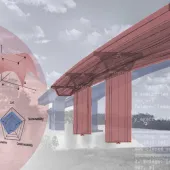ETH Zurich builds 30-metre printed tower
ETH Zurich completes 3D-printed concrete tower in Swiss Alps
ETH Zurich has completed the tallest known 3D-printed concrete structure in the world – a 30-metre-high tower constructed from digitally fabricated concrete elements. The project, located in the Alpine village of Mulegns, Switzerland, aims to demonstrate the potential of automated concrete construction for complex architectural forms.
Named Tor Alva – or White Tower – the four-storey structure is part of a broader collaboration between ETH Zurich and the Origen Foundation, a cultural group committed to revitalising the remote village. With just 20 residents, Mulegns will now be home to a high-profile structure designed to attract visitors and stimulate local activity through music, theatre and art programmes held in the tower’s upper dome.
The structure was developed by ETH professor Benjamin Dillenburger, together with architect Michael Hansmeyer and a team of ETH researchers specialising in structural engineering and building materials. Swiss firm Conzett Bronzini Partner also provided engineering support, while local contractor Zindel United helped deliver the on-site build.

Robotic printing with reinforced concrete
Unlike many other 3D-printed concrete projects, Tor Alva is load-bearing. The columns, which feature complex, branch-like forms and textured droplet patterns, were produced in ETH’s Robotic Fabrication Laboratory over a five-month period. Each 2-metre-high segment was printed using an extrusion-based method, with a robotic arm layering a specially formulated white concrete.
The concrete mix, developed by ETH professor Robert Flatt, contains two additives that allow for fast setting and fine surface detailing. “We had to make sure the material was soft enough to be shaped, but strong enough to support itself within minutes,” said Flatt.
During printing, a second robot inserted steel ring reinforcement every 26 centimetres. “Branched columns like these are almost impossible to cast conventionally,” said researcher Che Wei Lin. The reinforcement approach was co-developed with ETH spin-off Mesh and will be supported by a new test procedure designed by professor Walter Kaufmann to validate structural integrity in layered 3D prints.

Precision assembly and future reuse
A total of 124 printed elements were produced and assembled off-site before being transported to the remote valley. The base and capital for each column were cast in concrete using 3D-printed moulds developed by ETH start-up Saeki. The tower’s modules were then joined together in Mulegns using vertical reinforcement bars and bolted base plates. Each storey took just one day to assemble.
“This is a trial of circular construction,” said Dillenburger. “The tower is designed to be disassembled and rebuilt in a new location after five years.”
ETH Zurich, a leading research university with global reach, is known for its innovation in construction automation, structural engineering, and sustainable building technologies. Its researchers have been at the forefront of developing 3D concrete printing systems and automated reinforcement strategies.

Practical goals, not replacements
Dillenburger is quick to point out that additive manufacturing will not replace conventional construction. Instead, it can offer solutions in scenarios where design complexity, customisation, or resource efficiency are key. The printing process applies concrete only where needed, reducing waste and lowering material use.
“With labour shortages and material demands rising globally, automated methods like this could offer practical solutions,” said Ana Anton, who leads ETH’s digital construction research group. “But before they can be adopted more widely, we need real-world projects to prove they work at scale.”

Due to open in May 2025, the White Tower will stand as both a physical landmark and a proof-of-concept for future digital concrete construction – blending traditional Alpine craftsmanship with 21st-century technology.
ETH Zurich operates across civil engineering, robotics, architecture and material science and is active in international research partnerships across Europe and beyond. The Tor Alva project was funded by the Escher Circle via the ETH Foundation. The estimated cost has not been officially confirmed, though similar large-scale printing projects exceed CHF 1 million (£880,000).







